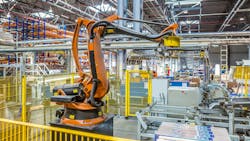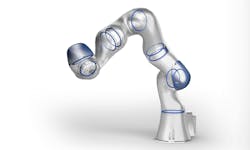Robotic Sealing: Understanding its Importance and the Selection Process
What you’ll learn:
- Why sealing technology is important to robot performance.
- Key criteria for selecting the right robotic sealing technology.
- How development of seals for other applications can benefit robotic sealing design.
Robots contain a wide range of components critical to their operation from actuators and bearings to motors and drives. An important yet often overlooked component in robotic design is seals.
Gregg Goings, Global Segment Manager, Freudenberg Sealing Technologies, said in an interview with Power & Motion that seals have not always been taken into consideration from a performance standpoint when designing a robot.
However, he said now that there are several robots out in the field, the industry is realizing the important role seals play in their performance. “Customers are recognizing that seals are [critical]. If you’re sealing an expensive bearing and the seal fails, then you’re going to replace the bearing as well,” he explained.
Because seals play an important role in the performance of robots and their components, it is equally as important to understand how to choose the right sealing technology for robotics applications.
How to Choose the Right Robotic Sealing Technology
Hunter Cheng, Global Segment Manager, Robotics, Freudenberg Sealing Technologies, explained to Power & Motion that the company’s seals are mainly used on the joints of robots “because that is the most important, key rotating [part of a robot].”
These robotic joints are not only doing repeated motions but also changing directions quickly and vigorously he said. Incorporation of seals into these joints ensure robotic motions can be done smoothly, without a problem over a long period of time.
Ensuring seals can withstand these operational requirements and enable the robot to continuously perform as desired factors into the seal design and the type chosen for a given application. When working with customers to determine the right seal technology for their robot design, Cheng said Freudenberg looks at several criteria, collectively named STAMP:
S – Speed
T – Temperature
A – Application
M – Medium
P – Pressure.
Understanding each of these aspects is necessary to ensure the right materials and physical properties are chosen to meet an end user’s performance requirements.
The operational speed of a robot, for instance, determines the operational conditions in which a seal will work due to the amount of torque generated. “If our materials are not robust enough, [the seal] will be destroyed during movement,” said Cheng.
Will grease, oil or other medium be used with the seals? This too is important to understand to ensure the right seal material is selected.
The end application in which a seal is used is also a critical determining factor for a seal’s design. If the robot will be used in a clean room or the food and beverage industry, special materials such as those approved by the FDA (U.S. Food and Drug Administration) must be utilized for a seal. There may also be regional standards which need to be considered.
Also knowing where on a robot sealing technology will be used. While the joints are where they are commonly used, they can also be located on the body of the robot as well as the end effectors, all of which determines the type of seal to employ.
Other important considerations that Goings noted are available space and friction. He said space is always an issue for customers and they are looking for the smallest sealing solution possible. Typically, the seal needs to fit within an existing envelope though ideally, he said Freudenberg would prefer to work with the customer to design the seal into the robot early on in the development process.
These space constraints may require the creation of a customized seal because a typical seal will not fit in the given space, said Cheng. In these cases, the seal needs to not only be small in size but also utilize a material thin enough to easily fit in the space without sacrificing desired performance characteristics such as lack of friction.
Friction is the number one factor customers consider when choosing a seal, said Goings, because they want zero friction. If friction occurs, it can cause heat buildup and other issues which have a negative impact on performance. “We’re always trying to take this into account in the design we’re offering,” he said. “We have to be aware of the space availability, which is a challenge, and to minimize as much as possible the friction and drag.”
Existing Seal Technology Expertise Benefits Developments for Robotics
Robotics is a young segment within Freudenberg, said Cheng, and the industry is always changing. Every day he said there is something new to learn or a new type of robotics technology entering the market such as humanoids which brings about new design challenges and requirements.
Due to the ever-evolving nature of the robotics industry and its unique requirements, the sealing technology Freudenberg develops for customers in this segment is typically custom.
However, the company is able to rely on its years’ of experience developing seals for other industries and applications. “Fortunately, we didn’t need to start from [scratch],” said Cheng. “We made use of previous experience in other applications.”
He offered the example of hydraulic drills which rotate quickly during operation. The company already understands the materials and other performance characteristics best suited to this type of application which can be applied to seals for robots as well because they too frequently rotate during operation.
Freudenberg primarily works with robot OEMs to develop sealing technology but will also work with tier-one suppliers of the motors, actuators, gearboxes and other components utilized in robots. By including proper sealing throughout a robot, long-term performance can be assured.
About the Author
Sara Jensen
Executive Editor, Power & Motion
Sara Jensen is executive editor of Power & Motion, directing expanded coverage into the modern fluid power space, as well as mechatronic and smart technologies. She has over 15 years of publishing experience. Prior to Power & Motion she spent 11 years with a trade publication for engineers of heavy-duty equipment, the last 3 of which were as the editor and brand lead. Over the course of her time in the B2B industry, Sara has gained an extensive knowledge of various heavy-duty equipment industries — including construction, agriculture, mining and on-road trucks —along with the systems and market trends which impact them such as fluid power and electronic motion control technologies.
You can follow Sara and Power & Motion via the following social media handles:
X (formerly Twitter): @TechnlgyEditor and @PowerMotionTech
LinkedIn: @SaraJensen and @Power&Motion
Facebook: @PowerMotionTech

Leaders relevant to this article:



